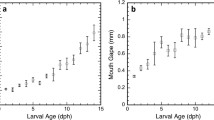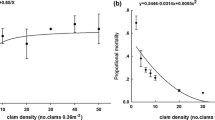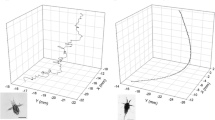Abstract
The foraging behavior and feeding ability of the cyclopoid copepod Oithona davisae, using the flagellate Tetraselmis tetrathele as prey organism, were observed microscopically and three dimensionally in a flow-cell. The distance between O. davisae and prey was estimated, and prey in front of the antennules or close to the mandible or mouthparts was ingested. Before attacking, O. davisae either sank or jumped. Both these motions are typical of foraging behavior. The instantaneous perceptive sphere was measured from the ingested prey position, while the encounter rate was estimated from the volume of the perceptive sphere, sinking speed, jump frequency plus swimming speed of prey. The calculated encounter rate was in good agreement with previously reported ingestion rates at low prey concentrations. From encounter rate and natural prey density, we conclude that O. davisae is capable of locating sufficient prey for its demands. Under natural conditions, where prey organisms may not be encountered regularly, the voracious O. davisae will ingest prey frequently when available. Our experimental methodology, devised to quantify the feeding abilities of O. davisae, is applicable to studying the foraging behavior of other copepod species.







Similar content being viewed by others
References
Durham, W. M. & R. Stocker, 2012. Thin phytoplankton layers: characteristics, mechanisms, and consequences. Annual Review of Marine Science 4: 177–207.
Gallienne, C. P. & D. B. Robins, 2001. Is Oithona the important copepod in the world’s oceans? Journal of Plankton Research 23: 1421–1432.
Giesecke, R. & H. E. González, 2004. Mandible characteristics and allometric relations in copepods: a reliable method to estimate prey size and composition from mandible occurrence in predator guts. Revista Chilena de Historia Natural 77: 607–616.
Henriksen, C. I., E. Saiz, A. Calbet & B. W. Hansen, 2007. Feeding activity and swimming patterns of Acartia grani and Oithona davisae nauplii in the presence of motile and non-motile prey. Marine Ecology Progress Series 331: 119–129.
Jiang, H. & G. A. Paffenhöfer, 2004. Relation of behavior of copepod juveniles to potential predation by omnivorous copepods: an empirical-modeling study. Marine Ecology Progress Series 278: 225–239.
Kiørboe, T., 2007. Mate finding, mating, and population dynamics in a planktonic copepod Oithona davisae: there are too few males. Limnology and Oceanography 52: 1511–1522.
Kiørboe, T., A. Andersen, V. J. Langloisb, H. H. Jakobsen & T. Bohr, 2009. Mechanisms and feasibility of prey capture in ambush-feeding zooplankton. Proceedings of the National Academy of Sciences 106: 12394–12399.
Kiørboe, T., H. Jiang & S. P. Colin, 2010. Danger of zooplankton feeding: the fluid signal generated by ambush-feeding copepods. Proceedings of the Royal Society B 277: 3229–3237.
Kjellerup, S. & T. Kiørboe, 2011. Prey detection in a cruising copepod. Biology Letters 8: 438–441.
Nakane, T., K. Nakaka, H. Bouman & T. Platt, 2008. Environmental control of short-term variation in the plankton community of inner Tokyo Bay, Japan. Estuarine, Coastal and Shelf Science 78: 796–810.
Nakata, K. & T. Nakane, 1987. Respiration of plankton in the Mikawa Bay. Pollution Control 22: 281–294.
Nielsen, T. G. & M. Sabatini, 1996. Role of cyclopoid Oithona spp. in North Sea plankton communities. Marine Ecology Progress Series 139: 79–93.
Ohtsuka, S., S. Ohtani, Y. Seike, H. Kunii & S. Nishida, 1999. Feeding habits of zooplankton, in particular, copepods in Lake Naka-umi. Laguna 6: 89–105.
Paffenhöfer, G. A., 2006. Oxygen consumption in relation to motion of marine planktonic copepods. Marine Ecology Progress Series 317: 187–192.
Paffenhöfer, G. A. & M. G. Mazzocchi, 2002. On some aspects of the behaviour of Oithona plumifera (Copepoda: Cyclopoida). Journal of Plankton Research 24: 129–135.
Prairie, J. C., P. J. S. Franks & J. S. Jaffe, 2010. Cryptic peaks: invisible vertical structure in fluorescent particles revealed using a planar laser imaging fluorometer. Limnology and Oceanography 55: 1943–1958.
Saiz, E., A. Calbet & E. Broglio, 2003. Effects of small-scale turbulence on copepods: the case of Oithona davisae. Limnology and Oceanography 48: 1304–1311.
Svensen, C. & T. Kiørboe, 2000. Remote prey detection in Oithona similis: hydromechanical vs. chemical cues. Journal of Plankton Research 22: 1155–1166.
Takahashi, K. & P. Tiselius, 2005. Ontogenetic change of foraging behaviour during copepodite development of Acartia clause. Marine Ecology Progress Series 303: 213–223.
Tsuda, A. & T. Nemoto, 1988. Feeding of copepods on natural suspended particles in Tokyo Bay. Journal of the Oceanographical Society of Japan 44: 217–227.
Uchima, M. & R. Hirano, 1988. Swimming behavior of the marine copepod Oithona davisae: internal control and search for environment. Marine Biology 99: 47–56.
Vogt, R. A., T. R. Ignoffo, L. J. Sullivan, J. Herndon, J. H. Stillman & W. J. Kimmerer, 2013. Feeding capabilities and limitations in the nauplii of two pelagic estuarine copepods, Pseudodiaptomus marinus and Oithona davisae. Limnology and Oceanography 58: 2145–2157.
Wu, C., K. Chiang & H. Liu, 2010. Diel feeding pattern and prey selection of mesozooplankton on microplankton community. Journal of Experimental Marine Biology and Ecology 390: 134–142.
Yen, J., 1988. Directionality and swimming speeds in predator–prey and male–female interactions of Euchaeta rimana, a subtropical marine copepod. Bulletin of Marine Science 43: 395–403.
Acknowledgements
This work was supported by JSPS Grant-in-Aid for Exploratory Research grant number 24658177.
Author information
Authors and Affiliations
Corresponding author
Additional information
Guest editors: Jiang-Shiou Hwang & Koen Martens / Challenges in Aquatic Sciences
Rights and permissions
About this article
Cite this article
Cheng, W., Akiba, T., Omura, T. et al. On the foraging and feeding ability of Oithona davisae (Crustacea, Copepoda). Hydrobiologia 741, 167–176 (2014). https://doi.org/10.1007/s10750-014-1867-8
Received:
Accepted:
Published:
Issue Date:
DOI: https://doi.org/10.1007/s10750-014-1867-8




